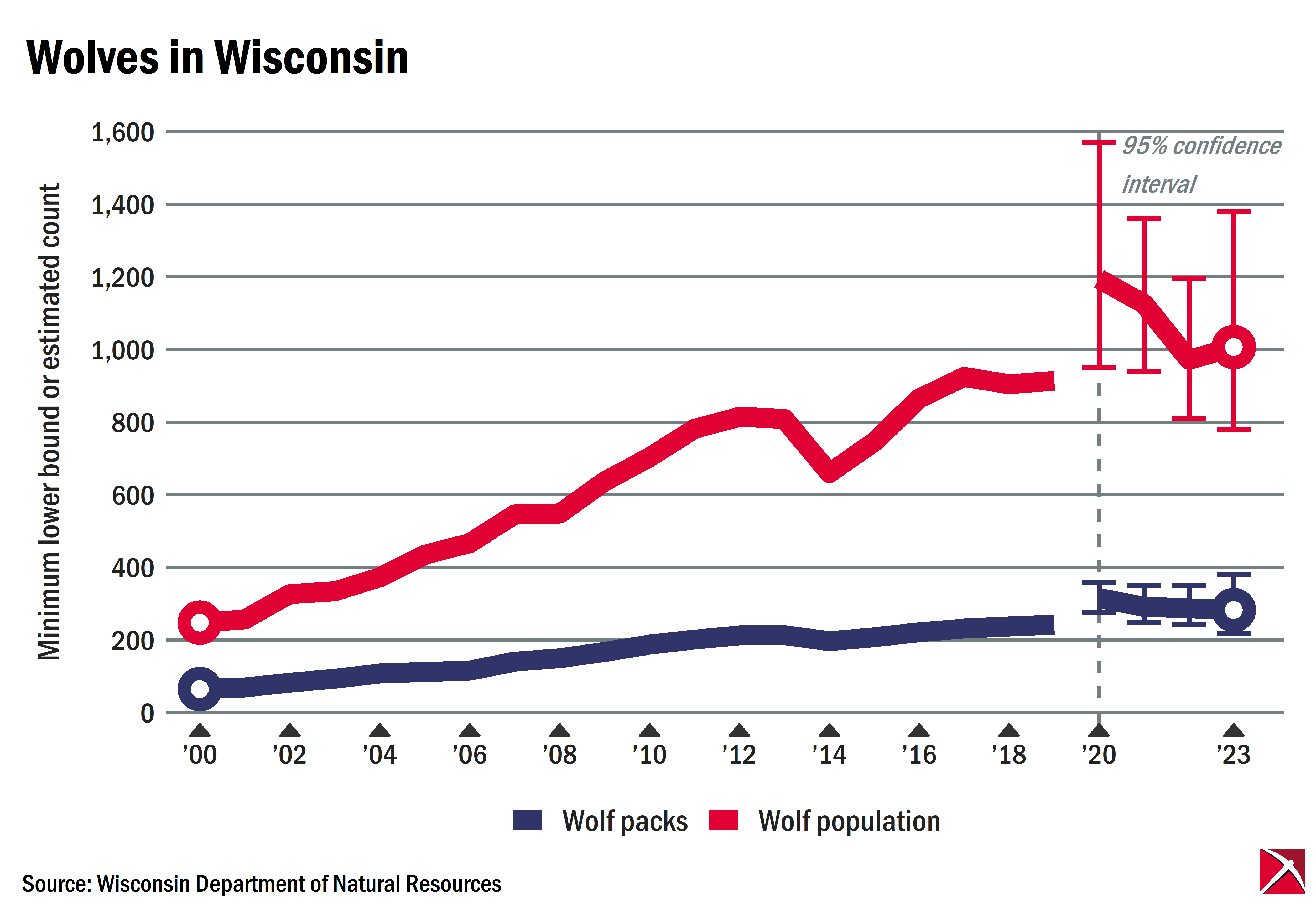By the numbers
The population of wolves roaming Wisconsin’s forests and farmlands exceeded 1,000 in 2023, data from the latest Department of Natural Resources wolf monitoring report show.
The gray wolf population has grown over the past quarter-century, according to published data. In 2000, there were estimated to be at least 65 wolf packs in Wisconsin with a combined population of 248 wolves. As of 2023, the most recent figures available, there were as many as 220 packs, and the population estimate was 1,007.

The graph above shows the DNR’s official population estimates over time. Until 2020, the DNR reported an estimated lower bound — an estimate of the minimum number of wolves living in the state. That means that in 2019, for example, there were at minimum 914 wolves. Beginning in 2020, the DNR switched to reporting an estimate and a 95% confidence interval. This means that while the agency’s best estimate was 1,195 wolves for 2020, there is a reasonably high chance that the true population was somewhere between about 950 and 1,550, the lower and upper bounds shown.
Wolf predation conflicts — that is, confirmed or probable depredation, injury, harassment or threat by wolves against livestock, dogs or humans — have increased from 59 in 2022 to 78 in 2023 and 98 in 2024, an analysis of DNR reports found.
Lawmakers in the U.S. Senate and House of Representatives have introduced bills this year that would delist wolves from federal endangered species status, giving the state the responsibility of managing the population in the interest of protecting pets and livestock. The gray wolf in western states already was delisted in 2011 due to population growth, and was later delisted in other parts of the country, including Wisconsin, leading to what one report described as a “see-saw” between federal and state control of wolf populations as environmentalists and Indian tribes pressed to have the wolf’s “endangered” status restored. U.S. Senators Tammy Baldwin and Ron Johnson jointly introduced a bill in 2022 to delist the wolf in Wisconsin.
The DNR estimates that 31 wolves died in Wisconsin in the year leading up to April 15, 2024. Of those deaths, 27 were human caused, while the cause of death for the remaining four unknown. Vehicle collisions accounted for 14 of the human-caused deaths, while 13 were killed by humans illegally.
The underlying numbers
| Year | Wolf Population Estimate | Estimated Pack Count |
| 2000 | 248 | 65 |
| 2001 | 257 | 70 |
| 2002 | 327 | 83 |
| 2003 | 335 | 94 |
| 2004 | 373 | 108 |
| 2005 | 435 | 113 |
| 2006 | 467 | 116 |
| 2007 | 546 | 141 |
| 2008 | 549 | 150 |
| 2009 | 637 | 168 |
| 2010 | 704 | 188 |
| 2011 | 782 | 202 |
| 2012 | 815 | 213 |
| 2013 | 809 | 214 |
| 2014 | 660 | 197 |
| 2015 | 746 | 208 |
| 2016 | 866 | 222 |
| 2017 | 925 | 232 |
| 2018 | 905 | 238 |
| 2019 | 914 | 243 |
| 2020 | 1,195 | 316 |
| 2021 | 1,126 | 262 |
| 2022 | 972 | 288 |
| 2023 | 1,007 | 283 |




